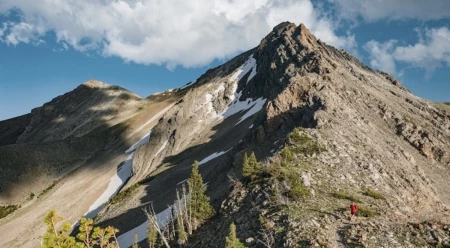A Very Large, Long Group Run Through the Bob Marshall Wilderness
For the slo-mo, bug-bitten, exhausted joy of really long runs.
Time expands and compresses on long runs. Moments of navigation or extended discomfort can seem endless, while the landscape sifts by like a slow-moving picture. And then suddenly it’s been hours that slipped by without you noticing, except for the subtle changes in light and accumulating fatigue.
Last summer I ran across the Bob Marshall Wilderness with a group of about 20 friends and family. My dad planned the route—just past the Hungry Horse Reservoir to Seeley Lake Campground— and recruited the runners. My boyfriend, Matt, and I flew up to help shuttle vehicles and food, and my younger brother met us at the trailhead. We camped on the fringes of this roadless wilderness, next to a group of horse packers who live there year-round, and set off the next morning just as the first light of dawn made it possible to run without a headlamp. The estimated distance was 45 miles, but early on someone realized we’d combined the topos wrong, and it was actually going to be more like 52.
Sixteen hours of ridgelines, blowdown, dusty open space, river crossings, contour lines, snowfields, changing layers, mosquitoes, filtered water, wildlife sightings, precarious climbs and one of the most amazing sunsets I’ve ever seen in my life, Matt and I stumbled out of the forest just above the lake. We followed the lantern-lit trail to camp, which looked like a tent city by the light of a blazing campfire. Someone handed me a beer. I’ve never wanted a beer more than in that moment.
Friends had driven up from Missoula to help cook food and hike Snickers and Coke to the last ridgeline for runners on their way out, so we passed on status reports to them and swapped stories with the runners who had already finished. There were the two we’d had to send out an alternate way because they’d probably never finish, who ended up hitchhiking to Hungry Horse and taking an Uber home; the mule trains we met; the guy camped deep in the backcountry who insisted on giving us water; the views from Picture Ridge; the spot where we forded the icy South Fork of the Flathead, holding hands and building eddies with our bodies to get to the opposite shore. I talked with my brother’s girlfriend, Sarah, by the fire until my legs eventually started hurting so badly neither sitting nor standing really felt tolerable. Matt was already asleep, so I crawled into my sleeping bag to wait for my dad and brother to finish, trying not to rub my raw skin against the nylon.
They finally did around 4 in the morning. Just before dawn, after a half bag of potato chips and a few sips of beer shared between us, the camp was silent.
This essay was featured in the February 2019 Patagonia Catalog.

